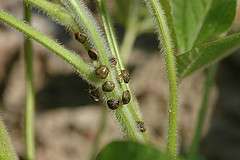Researcherargeting voracious Kudzu bug

Alabama Extension specialist and Auburn University professor Xing Ping Hu is gaining insight into the virulent kudzu bug, including the discovery of a native predator that could go a long way toward reducing the pest's numbers.
"Since its detection in 2009, this stink bug has developed from an urban nuisance to a serious bean crop pest throughout the Southeast," said Hu, an Alabama Cooperative Extension System entomologist and professor in the Department of Entomology and Plant Pathology. She added that its rapidly expanding range, explosive population growth, severe damage to legume crops and vegetables, repulsive smell and difficulty to control have contributed to its elevated pest status.
To date, the kudzu bugs have spread to 56 of Alabama's 67 counties since 2009. Hu said her research is intended to provide not only a clearer picture of the pest's feeding, mating and migratory habits but also effective control strategies and methods.
The biggest breakthrough of all is the detection of a native parasitoid found in the guts of several kudzu bugs dissected by Hu's graduate student researcher, Julian Golec.
The parasitoid, which Hu has determined to be a fly, ultimately could reduce the kudzu bug's numbers substantially over the next few years and also may prove to be an effective biological method to complement future control strategies.
"The presence of this parasite in the bugs we've detected is unusually high," she said. "We've even seen the larvae crawl out from several of the insects, pupate on the ground and emerge into flies, which, in turn, affect other bugs."
Hu said she has determined the family and genus of the fly and hopes to release that information within the next few weeks. Her next research priority is to determine conditions for optimizing the parasite's numbers.
"The discovery of this parasite is especially good news, as it may provide a viable alternative to an imported wasp species, allowing nature to take the exotic kudzu bug to task," Hu said.
Her initial research findings confirmed the pest's remarkable adaptability to new environments. Despite a special affinity for legumes, such as kudzu and soybeans, they can adapt to many other species. To sustain their long flights during migration, the bugs have even been detected feeding on Queen Anne's Lace, a common wild plant found along many Alabama roadsides.
"Sometimes you will see them feeding voraciously on all kinds of plants, including ornamental and horticultural plants, particularly in early spring and late fall when kudzu and soybeans plants are unavailable or unsuitable for feeding," she said.
Hu said she also has noted a penchant for long beans and green beans.
"If a kudzu bug population grows large enough, it's capable of wiping out these two crops," she said. "In fact, we have photos showing as many as 50 bugs on only one long bean pod."
Some plants have died from bug infestations. The same holds true for several other vegetable crops, such as lima beans, runner beans and string beans.
Hu also has discovered the female's ability to store sperm during the overwintering period – a rare trait among insects and one that provides the species with an especially valuable survival tool.
"The sperm can survive the entire winter, after which the stored sperm is released and the eggs fertilized," she said. "What this means is that a female kudzu bug doesn't need the presence of males when she flies to a new location to overwinter."
Hu said she has gained new insights into how females lay their eggs as well, depositing them strategically in early spring before the primary hosts, kudzu and soybeans, begin budding and leafing. She said the females often deposit egg masses on low plantations close enough for fast-growing kudzu to reach. Females also have been found depositing egg masses on tall plants and trees farther away so that the hatched larvae are blown by wind into the kudzu – a highly evolved dispersal method, she says.
Hu has determined that kudzu bugs migrate into soybeans only after the plants have reached a foot in height. She said she hopes these findings will provide homeowners and farmers alike with more effective methods to remove habitats that promote the pest's spread.
Provided by Auburn University



















